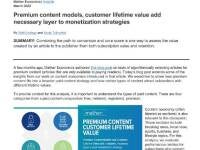
Partner content*: Publishers should take a holistic approach to monetising content and look at the lifetime value of a customer if they want to understand how to make publishing news online pay.
Business consultancy Mather Economics – which counts Le Monde, Bloomberg and the Wall Street Journal among its many clients – said publishers should align the three biggest parts of their organisation (the newsroom, technology and consumer marketing) in setting out their monetisation strategy.
“Execution is about how well those three groups can work together,” said Arvid Tchivzhel, managing director of digital consulting at Mather.
The company formed in 2002 and is headquartered in Atlanta, Georgia. Dutch media group Mediahuis took a 35% stake in Mather in November 2019, expanding its services outside the US for the first time, including an office in Amsterdam. It is now looking to take on UK clients.
For many UK publishers, the pandemic accelerated a move towards reader revenues, reacting to a declining advertising market, as events dried up and companies faced financial difficulties, and readers actively seeking out trusted information on Covid-19, lockdowns and vaccines.
Tchivzhel said the answer to the question of how to monetise content is usually to put up a paywall, but, speaking at a webinar hosted by Mather in April, he said it’s really about “how do you match the content you’re producing with the value readers will find from it… how do you holistically, as a company, come together and hit your goals on monetising your content?”
For Mather, the “North Star” is customer lifetime value, which it assesses at the customer level.
Tchivzhel said lifetime value is the “combination of the entire customer funnel”, from attracting readers through SEO and social media at the top, down to converting readers into subscribers at the bottom, and engagement (personalisation, newsletters, data walls etc.) in the middle.
In its white paper on premium content models, Mather said it tracks the “path to conversion” (how many times an article was read by a visitor in the 30 days prior to starting their subscription) and “core score” (an index measuring readers in the publisher’s core audience) metrics to assess the value created by an article, both in terms of acquisition and retention of subscribers.
“You have all this data on that one article and if you were to summarise that into one magic score, it’s really a ‘lifetime value’ score,” said Tchivzhel.
He said using a lifetime value metric helps align a publisher’s best interests in the long term, rather than “this frantic going back and forth” between acquisition and retention.
Mather serves more than 200 clients across over 600 markets, with more than 50 employees worldwide made up mostly of economists and data scientists.
Tchivzhel said the company helps client publishers optimise their “article mix” by looking at the purpose of an article, be that driving revenue or simple journalistic value, rather than simply thinking “we have to publish this crime story that’s just a paragraph long”.
He pointed to the “five user needs”, as set out by former BBC World Service digital editor Dmitry Shishkin, as a guide to publishers on optimising content. Ensuring an article either updates, educates, inspires, keeps someone on trend, gives them perspective or diverts them.
“It’s not just the content or taxonomy of the article, but it’s also what is it actually doing. What user need are you fulfilling?” said Tchivzhel.
Publishers should also consider supply and demand. Tchivzhel said: “Sometimes we see this problem where [a website] might publish 200 articles on sports, but half don’t even get read because there’s so much content being produced that there’s not enough space on the homepage…
“So in some cases you want to reduce the supply of that content, or be a bit more diligent about when you publish, how frequently and which channel you’re pushing it to.”
When it comes to pricing, Tchivzhel said “the days of one price working for everybody” are “long gone”, adding: “Every other industry, to some extent, has dynamic pricing.” Customers are used to paying different amounts for a can of Coke from a vending machine or a restaurant, he said, and similarly access to news can be strategically priced according to who’s buying.
“We know that some customers are going to be more highly sensitive to price. For those folks, you can extend the discount and focus on achieving a certain level of engagement first,” Tchivzhel said.
“If you get a subscriber on a three-month trial at a discount, but that customer still hasn’t really engaged the way you want them to, they haven’t logged in too much, well extend that trial, maybe three more months, and really focus on personalising the homepage for them or curating a custom newsletter for that user based on what their interests are, what they what they read initially.
“There are ways you can use data in pricing to figure out what’s the right price or even the timing of that price change. If you were to price that customer who is disengaged too soon, you’re probably going to lose them, but if you engage them then you can price them more aggressively.”
*This article was sponsored by Press Gazette commercial partner Mather Economics
Premium content models, customer lifetime value add necessary layer to monetization strategies
Email pged@pressgazette.co.uk to point out mistakes, provide story tips or send in a letter for publication on our "Letters Page" blog

